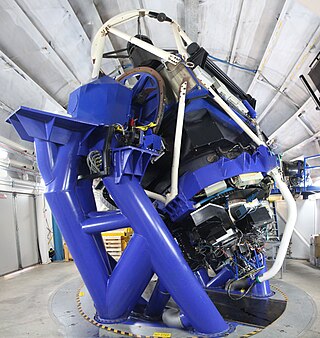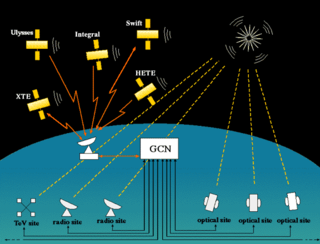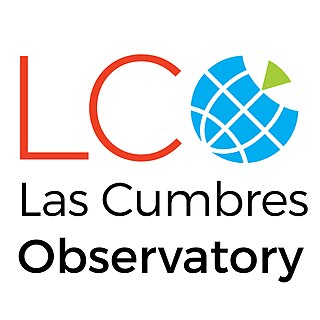
The European Organisation for Astronomical Research in the Southern Hemisphere, commonly referred to as the European Southern Observatory (ESO), is an intergovernmental research organisation made up of 16 member states for ground-based astronomy. Created in 1962, ESO has provided astronomers with state-of-the-art research facilities and access to the southern sky. The organisation employs over 750 staff members and receives annual member state contributions of approximately €162 million. Its observatories are located in northern Chile.

BeppoSAX was an Italian–Dutch satellite for X-ray astronomy which played a crucial role in resolving the origin of gamma-ray bursts (GRBs), the most energetic events known in the universe. It was the first X-ray mission capable of simultaneously observing targets over more than 3 decades of energy, from 0.1 to 300 kiloelectronvolts (keV) with relatively large area, good energy resolution and imaging capabilities. BeppoSAX was a major programme of the Italian Space Agency (ASI) with the participation of the Netherlands Agency for Aerospace Programmes (NIVR). The prime contractor for the space segment was Alenia while Nuova Telespazio led the development of the ground segment. Most of the scientific instruments were developed by the Italian National Research Council (CNR) while the Wide Field Cameras were developed by the Netherlands Institute for Space Research (SRON) and the LECS was developed by the astrophysics division of the European Space Agency's ESTEC facility.
The Max Planck Institute for Extraterrestrial Physics is a Max Planck Institute, located in Garching, near Munich, Germany. In 1991 the Max Planck Institute for Physics and Astrophysics split up into the Max Planck Institute for Extraterrestrial Physics, the Max Planck Institute for Physics and the Max Planck Institute for Astrophysics. The Max Planck Institute for Extraterrestrial Physics was founded as sub-institute in 1963. The scientific activities of the institute are mostly devoted to astrophysics with telescopes orbiting in space. A large amount of the resources are spent for studying black holes in the galaxy and in the remote universe.

The Liverpool Telescope (LT) is a two-metre-aperture robotic Ritchey–Chrétien telescope that observes autonomously. However professional astronomers, school groups and other credible registered users submit specifications to be considered by its robotic control system (RCS) at any time using an online graphical user interface. Each night the RCS decides among these choices, and among any notified or glimpsed transient events, what to observe, based on target visibility and weather conditions.
Andreja Gomboc is a Slovenian astrophysicist.

A robotic telescope is an astronomical telescope and detector system that makes observations without the intervention of a human. In astronomical disciplines, a telescope qualifies as robotic if it makes those observations without being operated by a human, even if a human has to initiate the observations at the beginning of the night or end them in the morning. It may have software agents using artificial intelligence that assist in various ways such as automatic scheduling. A robotic telescope is distinct from a remote telescope, though an instrument can be both robotic and remote.

The Faulkes Telescope South is a clone of the Liverpool Telescope and is located at Siding Spring Observatory in New South Wales, Australia. It is a 2 m (79 in) Ritchey-Chrétien telescope. It was designed to be operated remotely with the aim of encouraging an interest in science by young people. It is supported by an altazimuth mount.

An astronomical survey is a general map or image of a region of the sky that lacks a specific observational target. Alternatively, an astronomical survey may comprise a set of images, spectra, or other observations of objects that share a common type or feature. Surveys are often restricted to one band of the electromagnetic spectrum due to instrumental limitations, although multiwavelength surveys can be made by using multiple detectors, each sensitive to a different bandwidth.

Konkoly Observatory is an astronomical observatory located in Budapest, Hungary is part of the Research Centre for Astronomy and Earth Sciences and belongs to the Eötvös Loránd Kutatási Hálózat. It was founded in 1871 by Hungarian astronomer Miklós Konkoly-Thege (1842–1916) as a private observatory, and was donated to the state in 1899. Konkoly Observatory, officially known as ELKH CSFK Konkoly Thege Miklós Csillagászati Intézet in Hungarian, is the largest astronomical research institute in Hungary, and hosts the largest telescopes in the country. The Observatory has more than 60 researchers, a quarter of them are non-Hungarian.

The Astronomical Observatory of Rome is one of twelve Astronomical Observatories in Italy. The main site of the Observatory is Monte Porzio Catone. Part of the Istituto Nazionale di Astrofisica since 2002.

The general coordinates network (GCN), formerly known as the gamma-ray burst coordinates network, is an open-source platform created by NASA to receive and transmit alerts about astronomical transient phenomena. This includes neutrino detections by observatories such as IceCube or Super-Kamiokande, gravitational wave events from the LIGO, Virgo and KAGRA interferometers, and gamma-ray bursts observed by Fermi, Swift or INTEGRAL. One of the main goals is to allow for follow-up observations of an event by other observatories, in hope to observe multi-messenger events.

Las Cumbres Observatory (LCO) is a network of astronomical observatories run by a non-profit private operating foundation directed by the technologist Wayne Rosing. Its offices are in Goleta, California. The telescopes are located at both northern and southern hemisphere sites distributed in longitude around the Earth. For some astronomical objects, the longitudinal spacing of telescopes allows continuous observations over 24 hours or longer. The operating network currently consists of two 2 meter telescopes, nine 1 meter telescopes, and seven 40 cm telescopes, placed at six astronomical observatories. The network operates as a single, integrated, observing facility, using a software scheduler that continuously optimizes the planned observing schedule of each individual telescope.
VOEvent is a standardized language used to report observations of astronomical events; it was officially adopted in 2006 by the International Virtual Observatory Alliance (IVOA). Though most VOEvent messages currently issued are related to supernovae, gravitational microlensing, and gamma-ray bursts, they are intended to be general enough to describe all types of observations of astronomical events, including gravitational wave events. Messages are written in XML, providing a structured metadata description of both the observations and the inferences derived from those observations. The rapid dissemination of event data with a formalized language was the original impetus for the creation of VOEvents and the network used to transport the messages; indeed VOEvent messages are designed to be compact and quickly transmittable over the internet. The VOEvent language continues to evolve; the latest version is 2.0.
RoboNet-1.0 was a prototype global network of UK-built 2-metre robotic telescopes, the largest of their kind in the world, comprising the Liverpool Telescope on La Palma, the Faulkes Telescope North on Maui (Hawaii), and the Faulkes Telescope South in Australia, managed by a consortium of ten UK universities under the lead of Liverpool John Moores University. For the technological aims of integrating a global network to act effectively as a single instrument, and maximizing the scientific return by applying the newest developments in e-Science, RoboNet adopted the intelligent-agent architecture devised and maintained by the eSTAR project.

The Gamma-Ray Burst Optical/Near-Infrared Detector (GROND) is an imaging instrument used to investigate Gamma-Ray Burst afterglows and for doing follow-up observations on exoplanets using transit photometry. It is operated at the 2.2-metre MPG/ESO telescope at ESO's La Silla Observatory in the southern part of the Atacama desert, about 600 kilometres north of Santiago de Chile and at an altitude of 2,400 metres.

GRB 090423 was a gamma-ray burst (GRB) detected by the Swift Gamma-Ray Burst Mission on April 23, 2009 at 07:55:19 UTC whose afterglow was detected in the infrared and enabled astronomers to determine that its redshift is z = 8.2, which makes it one of the most distant objects detected to date with a spectroscopic redshift.

Gamma-ray astronomy is the astronomical observation of gamma rays, the most energetic form of electromagnetic radiation, with photon energies above 100 keV. Radiation below 100 keV is classified as X-rays and is the subject of X-ray astronomy.

Aryabhatta Research Institute of Observational Sciences (ARIES) is a research institute in Nainital, Kumaon, India which specializes in astronomy, solar physics, astrophysics and atmospheric science. It is an autonomous body under the Department of Science and Technology, Government of India. The institute is situated at Manora Peak (elevation 1,951 m or 6,401 ft), about 9 kilometres (5.6 mi) from Nainital, headquarters of Kumaon division.
Carole Mundell is Professor of Extragalactic Astronomy at the University of Bath. She is an observational astrophysicist who researches cosmic black holes and gamma ray bursts.













